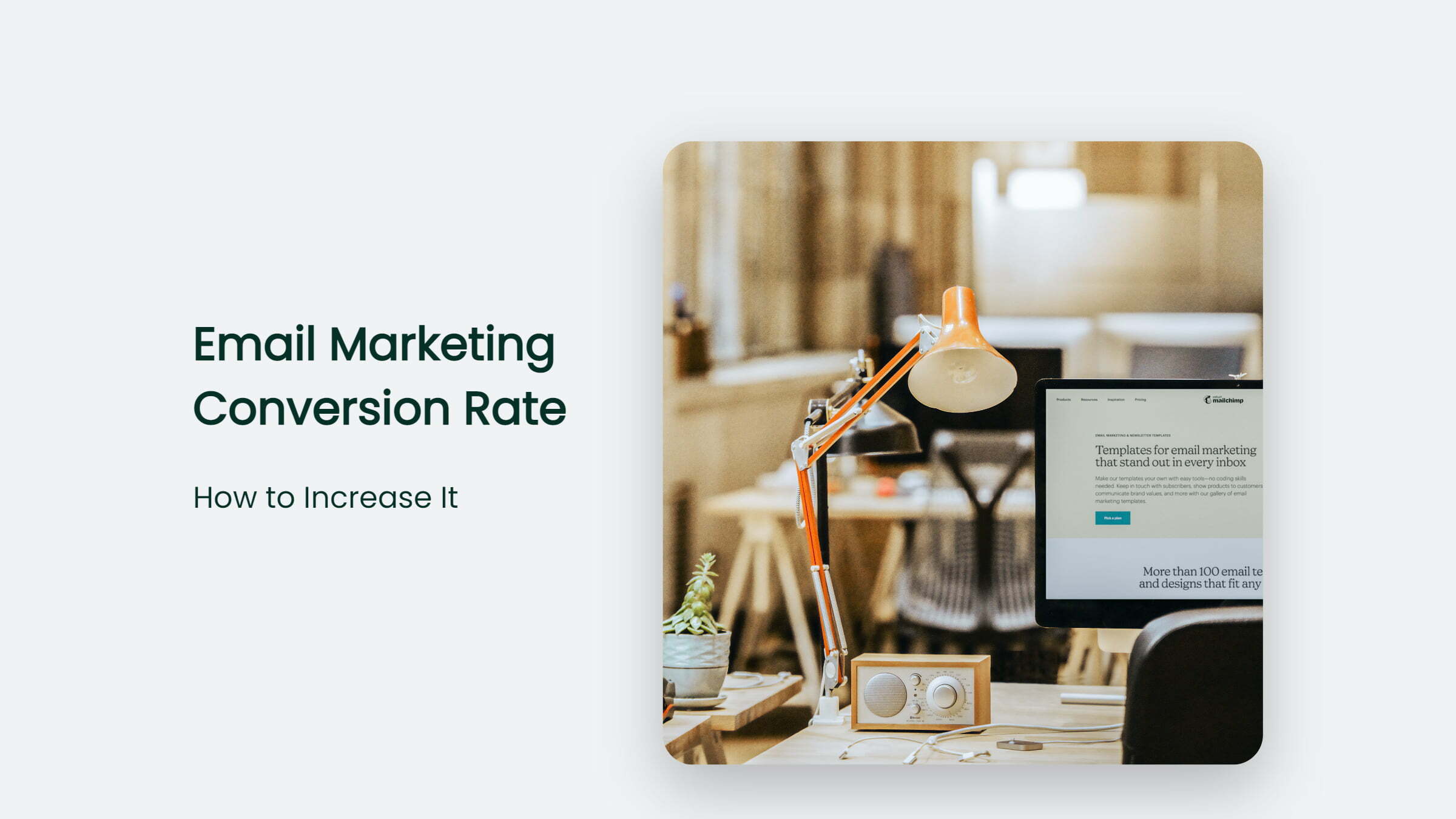

How to Increase Your Email Marketing Conversion Rate

As Seen On
Email marketing is a great way to connect with your customers and promote your products or services.
However, one of the email marketing challenges is getting people to read your emails and take action on them.
In this blog post, we’ll share tips on how to increase your email marketing conversion rate so that more people read and act on your emails.
Table of Contents
But first, let’s understand email marketing.

Is email marketing still relevant?
Despite the proliferation of social media and other digital marketing platforms, email marketing is a highly effective way to reach consumers.
Not only is email incredibly versatile, allowing marketers to target specific demographics and customize messages in a broad range of formats, but it also allows them to build more personal relationships with customers by getting to know their interests and preferences.
Email often yields much better response rates than more “noisy” channels like social media or paid search advertising.
In short, while there are many newer tools for reaching potential customers, email has shown that it is still very relevant in today’s digital landscape.
With this tool’s intelligent and strategic use, companies can reach new heights in customer engagement and conversion.
What is an Email Conversion Rate?
An email conversion rate refers to the percentage of emails successfully converted into sales or other desired actions.
It can be determined by dividing the number of sales or other conversions by the number of emails sent and multiplying by 100%.
An email conversion rate is typically calculated over a certain period, such as a week or month.
Factors that can affect an email conversion rate include the quality of a company’s email list, the relevance and timing of its messages, and the incentives it offers to encourage customers to take action.
A high email conversion rate can help businesses to achieve their marketing goals more quickly and efficiently. In contrast, a low email conversion rate may indicate that changes need to be made to increase sales.
3 Reasons you didn’t know cause a low email conversion rate

You’re not building your list organically.
If you’re not actively working to grow your email list, then it’s likely that your conversion rate will be low.
It is because a smaller list means that there are fewer people to whom you can send your messages.
Additionally, if you’re not growing your list organically, then it’s likely that the people on your list are not as engaged as they could be
To grow your list organically, you need to focus on providing value to potential subscribers and making it easy for them to sign up for your emails.
Your emails are not relevant to your audience.
Another reason you might have a low email conversion rate is because your emails need to be more relevant to your audience.
If you need to segment your list correctly or send timely and targeted messages, it can happen.
When your emails are irrelevant to your audience, people are less likely to open them, let alone take action on them.
To avoid this, you need to ensure that you’re segmenting your list correctly and sending targeted and timely messages to each segment.
You’re not offering any incentive for conversion.
If you’re not offering anything of value in exchange for a sale or other desired action, then it’s likely that people will take that action.
To increase your email conversion rate, you need to offer something that will motivate people to take the desired action.
It could be a discount, a free shipping offer, or access to exclusive content.
Whatever it is, make sure that it’s something that your audience will find valuable and that it’s clearly stated in your email.
You’re much more likely to increase your email conversion rate and achieve your desired results by offering an incentive.
Email marketing can be a highly effective way to reach consumers and convert them into customers. However, a low email conversion rate can indicate that changes need to be made to increase sales.
To avoid this, companies should focus on building their list organically, sending relevant and targeted messages, and offering incentives for conversion.
How to Increase Your Email Marketing Conversion Rate:

Keep Your Emails Short and Sweet
Most people are bombarded with emails daily, so making yours as concise and to the point as possible is essential. Get straight to the point and avoid using too much filler text. People are more likely to read and act on an email if they can quickly understand it.
Use Strong Calls-to-Action
Your call-to-action (CTA) is what tells your subscribers what you want them to do next. It should be clear, concise, and actionable. For example, if you’re promoting a new product, your CTA could be like, “Click here to learn more about our new product.”
Use Engaging Images
Images are great for grabbing attention and making your emails more visually appealing. People are more likely to click on an email that has an engaging image than one that doesn’t. If you’re promoting a new product, include a photo of the product in your email. Use only a few photos, which can make your email appear cluttered.
Personalize Your Emails
Personalized emails perform better than generic ones because they show that you know your subscriber and what they’re interested in. There are several ways you can personalize your emails, such as using the person’s name in the subject line or body of the email or segmenting your list so that you only send relevant content to each subscriber.
Test, Test, Test!
One of the best ways to find out what works for your business is to test different things and see what gets the best results. Try different subject lines, CTAs, images, etc., and see which ones have the highest click-through rates. You can also A/B split test your emails by sending two different versions of the same email to a small group of subscribers and seeing which one performs better before sending it out to your entire list.
Check Open Rates And Email Deliverability
To increase your email conversion rate, it is essential to monitor open rates and email deliverability.
A high open rate indicates that your subscribers are interested in the content of your emails and may be more likely to convert.
In addition, keeping track of email deliverability will help you ensure that your messages always reach your intended recipients, avoiding those dreaded spam filters.
By consistently examining these metrics and optimizing where necessary, you can successfully boost your email conversion rate and enjoy greater engagement with your subscribers.
Focus On The Frequency Of Emails
To increase your email conversion rate, it is essential to focus on the frequency of emails that you send.
For most businesses, sending out a new email every day or two can help to keep your subscribers engaged and interested in your products or services.
However, bombarding them with too many messages at once can have the opposite effect and overwhelm your audience, resulting in fewer conversions.
By planning and strategising each email campaign carefully, you can ensure that you are consistently reaching out to potential customers while avoiding burnout.
Increasing your email conversion rate ultimately relies on striking a careful balance between delivering valuable content and respecting your subscribers’ time.
Optimize Your Emails For Mobile Devices
Optimising all aspects of your email for mobile users is essential to maximise your email marketing campaign’s conversion rate.
It means ensuring that text and images are easily viewed on smaller screens and that links are accessible with a single tap or swipe.
It would help if you also considered testing different subject lines and content to find the most effective messaging for readers on mobile devices.
By taking these steps and paying careful attention to user experience, you can dramatically improve your email marketing campaign’s conversion rate and see better results from your marketing efforts overall.
Use Autoresponders for Opt-ins
Several strategies can be used to increase email conversion rates.
One particularly effective method is the use of autoresponders for opt-ins.
Autoresponders allow you to automatically generate a series of emails to new subscribers, giving them valuable information and increasing their engagement with your brand from the very start.
Including CTAs in these messages can encourage readers to take the next step along their customer journey, whether purchasing a product or filling out an online form.
Ultimately, using autoresponders to increase email conversion rates can boost your email marketing ROI and drive better results overall.
Create a Sales Funnel to Increase the Email Conversion Rate
Creating an effective sales funnel is one of the most critical steps in improving email conversion rates.
A well-designed sales funnel will help to engage potential customers at key points throughout the buying process, ultimately leading them to take the desired actions.
It can be achieved through persuasive copywriting, targeted CTAs, and well-placed incentives.
For instance, you might begin by providing clear and compelling value propositions in your subject lines that draw readers in, followed by a series of engaging emails that speak directly to their needs and interests.
Additionally, you could include links to content that encourages subscribers to share their contact information or sign up for a free trial.
Focusing on your customers’ needs and incorporating proven marketing strategies into every step of the funnel can increase email conversion rates and ultimately drive more sales.
Build trust
To increase email conversion rates, building trust with your audience is important.
It can be done in several ways, such as presenting yourself as a credible and knowledgeable source, providing clear and transparent contact information, and creating relevant content to your readers.
Additionally, you can enhance trust by being consistent in your messaging and tone, responding promptly to inquiries and concerns, and focusing on presenting solutions instead of just highlighting problems.
By taking these steps, you can help connect more deeply with your subscribers, resulting in higher conversion rates for your email campaigns.
Frequently Asked Questions:
What is a good conversion rate for email marketing?
A good conversion rate for email marketing can vary depending on your industry and your campaign type. However, a general benchmark to aim for is around 2-3%
How to calculate the email conversion rate?
To calculate the email conversion rate, divide the number of conversions by the total number of email recipients. For example, if you had 100 conversions from a mailing list of 1,000 people, your email conversion rate would be 10%
What is a good open rate for email marketing?
A reasonable open rate for email marketing can vary depending on your industry and the type of campaign you are running. However, a general benchmark to aim for is around 20-30%
The Bottom Line:
Email marketing can be a great way to reach out to potential customers, but you have to ensure your email stands out in their inboxes and has high conversion rates.
By following the tips in this blog post, you can learn how to improve your email marketing strategy and get more leads.
And if you need help implementing these changes or want expert guidance on which strategies will work best for your business, contact us today.
We’d be happy to chat with you about how we can increase your email marketing conversion rate and help you get more sales.
Casey Jones
Up until working with Casey, we had only had poor to mediocre experiences outsourcing work to agencies. Casey & the team at CJ&CO are the exception to the rule.
Communication was beyond great, his understanding of our vision was phenomenal, and instead of needing babysitting like the other agencies we worked with, he was not only completely dependable but also gave us sound suggestions on how to get better results, at the risk of us not needing him for the initial job we requested (absolute gem).
This has truly been the first time we worked with someone outside of our business that quickly grasped our vision, and that I could completely forget about and would still deliver above expectations.
I honestly can't wait to work in many more projects together!
Disclaimer
*The information this blog provides is for general informational purposes only and is not intended as financial or professional advice. The information may not reflect current developments and may be changed or updated without notice. Any opinions expressed on this blog are the author’s own and do not necessarily reflect the views of the author’s employer or any other organization. You should not act or rely on any information contained in this blog without first seeking the advice of a professional. No representation or warranty, express or implied, is made as to the accuracy or completeness of the information contained in this blog. The author and affiliated parties assume no liability for any errors or omissions.

